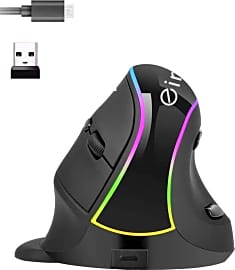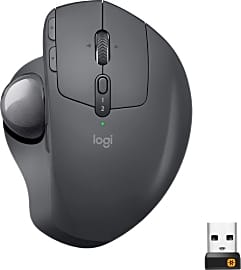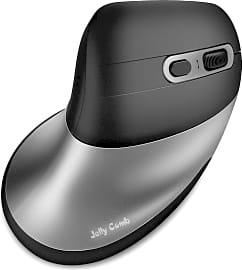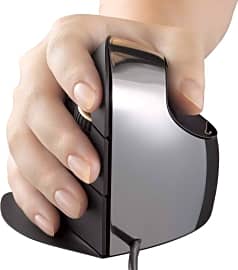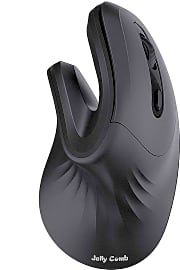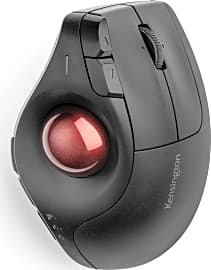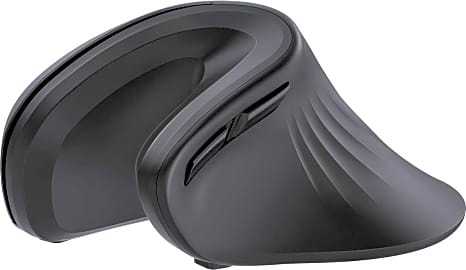The 10 Best Vertical Mice

This wiki has been updated 40 times since it was first published in March of 2015. If your job has you tied to a computer for long stretches, or if you're an avid PC gamer, you can relieve the strain on your wrist and forearm with one of these vertical mice. They are ergonomically designed and scientifically proven to reduce most of the common joint stresses brought on by the frequent use of a regular mouse, so you can do more work – or have more fun – with less pain. When users buy our independently chosen editorial recommendations, we may earn commissions to help fund the Wiki.
Editor's Notes
January 11, 2021:
As much as possible we wanted to include models that provide several connectivity options during this update, and no option more illustrates that than the Logitech MX 910, which offers Bluetooth, USB wireless via dongle, and a wired connection. We also think hand position versatility is important to preventing wrist pain over time, which is we highly recommend the Logitech MX Ergo. This has an adjustable tilt, so you can use it like a traditional mouse, or set it to a more vertical orientation as needed. When it comes to gaming, it is generally best to buy a dedicated model as these will have the highest sensitivity settings, the least lag, and often the most customizability, and the Zlot G19C18 proves this by having a 10,000 DPI and 1,000-hertz polling rate, which is rare in vertical models.
December 24, 2019:
Looking over the options on our previous list, it struck me how many offerings were wired, when so many other things in our daily lives and smart homes are wireless. It was important to see an overhaul here in the direction of a mostly wireless list.
Of course, there are still some good reasons to go wired, like avoiding the headache of battery charging or replacement, as well as the occasional hassle of connecting and reconnecting wirelessly to your computer. And we found some excellent wired options like the Posturite Wired Penguin, which places its buttons on the forward edge of the grip, taking a lot of tension out of your index and middle fingers while also making it symmetrical to accommodate both left- and right-handed users.
Beyond that, DPI and ergonomics were the most important features, with the 57-degree angle and 4000 DPI sensitivity of the Logitech Wireless MX Advanced placing it high up in the ranking. Its price was the only thing that held it back slightly. A few other things we scrutinized were click ratings, battery performance (for wireless models), and warranty service, the best balance of which could be found in the Jelly Comb Bluetooth Ergonomic.
The Vertical Mouse And Ergonomic Advantages
While it might take some getting used to initially, you are going to love the convenience and won't want to go back to a regular computer mouse ever again.
A vertical mouse is a useful device for your desktop or laptop that will allow you more natural movement in your arm and wrist. If you spend your days sitting at a computer clicking and typing all day long, your hands can get tired, tingly, sore, and even numb at times.
A vertical computer mouse is designed to take some of this pressure off your wrist and arm and help you to move more freely. While it might take some getting used to initially, you are going to love the convenience and won't want to go back to a regular computer mouse ever again.
Go ahead and put your hand on your regular computer mouse. Do you notice the tension in your thumb and pinky finger? A vertical mouse will prevent your wrist from pronating and your fingers from tensing. Your arm's natural wresting position is with the thumb facing up. A regular computer mouse does not support this position and can cause unnecessary strain. A vertical mouse requires you to bend at the elbow rather than at the wrist so you can save on strain and the risk of incurring repetitive strain injuries.
There are many types of vertical mice to choose from. Each of them are designed with comfort and convenience in mind. Unfortunately, there are many on the market that are not left-handed friendly, so if you are left-handed you will have to ensure that you purchase one that you can use.
The buttons on a vertical mouse may seem to be strangely placed at first, but once you put your hand on it, you will realize that they are conveniently placed where your hand naturally rests. You can choose from designs that cradle your hand and wrists or some that stand completely upright allowing you to grip them the way you might a joystick.
It is becoming widely accepted that ergonomically designed office equipment improves health and increases productivity. When you are comfortable, you will produce better work. A vertical mouse with a quality ergonomic design might just be what you need to power through your work day.
Consider Your Options
You might be in the market for a vertical mouse because of a desire to avoid carpal tunnel syndrome, to relieve arthritis pain, or simply because you desire greater comfort in your home or office. Maybe you want a mouse that will turn heads and start a fun conversation. Whatever your end goal is, a vertical mouse is probably the right choice for you.
If you are left-handed, make sure that the mouse you have chosen has a left-handed option.
It is important to note that not all vertical mice are created equal. While each are ergonomically engineered, there is a wide variety of designs. What works best for one person might not be the right choice for you. It is important to consider your specific needs when choosing a vertical mouse.
Some vertical mice come in a variety of sizes. Consider this before purchasing so that you can ensure that you get one that will best fit your hand. While you might not feel that size matters in the grand scheme of things, the purpose of your vertical mouse is comfort first and foremost. If the mouse is too small or too big, you are going to struggle to learn to use it and significantly delay your work day.
If you are left-handed, make sure that the mouse you have chosen has a left-handed option. Unfortunately, some companies still haven't gotten with the program and made accommodations for left-handed customers. However, there are a number of options out there for vertical mice with ambidextrous designs.
Consider how your hand will be most comfortable. Do you want a vertical mouse that will cradle your hand and wrist? Or would you prefer one that sits more upright and allows you more control? Perhaps experiment with a few vertical mice to see which one might be the right choice for you.
A Brief History Of The Vertical Mouse
In 1941, Ralph Benjamin invented a pointing device called a trackball. He was working for the British Royal Navy Scientific Service during World War II. The navy was initially using joysticks to calculate and pinpoint the anticipated positions of their target aircraft. Benjamin felt that it was necessary to develop a more accurate, sophisticated device.
Today, there are many types options for computer mice beyond the antiquated rollerball system.
It wasn't until October 2, 1968 that the first version of the rollerball computer mouse was released by the German company, Telefunken. Over the next several years, there were many other pointing devices created and marketed, many of which used the rollerball design.
In 1973, Xerox released the Xerox Alto for individual use, and it is one of the first computers to use a mouse. In 1983, Microsoft developed the MS-DOS program and sold their own version of the computer mouse along with their computers. By 1984, computer mice were becoming commonplace hardware sold with computers.
Today, there are many types options for computer mice beyond the antiquated rollerball system. Users may now choose between wireless laser mice that connect through Bluetooth or USB, or wired mice that connect directly to the computer through the USB port.
Vertical mice were developed in the early 1990s as an alternative to the average computer mouse. However, it is only in recent years that they have been gaining popularity.


